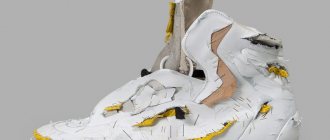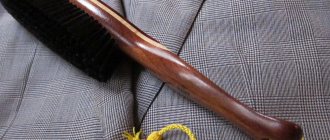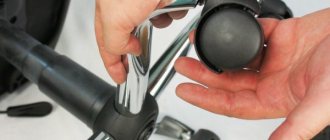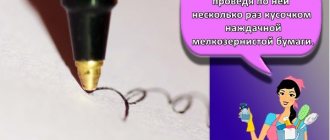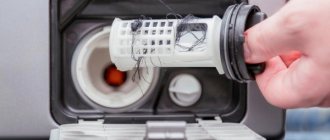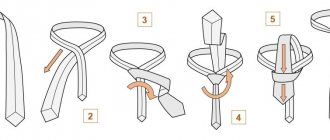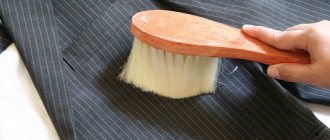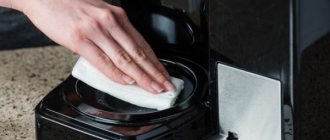Receive one of the most read articles by email once a day. Join us on Facebook and VKontakte.
Who doesn't want to own only quality things? But now the world is ruled by the mass market. And it is somewhat naive to expect quality from Zara sneakers like the latest Adidas collection. Although a reputable brand is by no means a guarantee of quality. If you notice that your sneakers or sneakers are starting to wear out on the backs, then don’t rush to get upset and save up for new ones. This common problem can be dealt with at home. This is what folk craftsmen advise.
The heel of a shoe is the first place to show signs of wear. Especially when it comes to sneakers or sneakers. And while the lining is being wiped from the inside, many ignore the alarm signal. But when the material begins to crack on the outside... To avoid it being too late, take action as soon as you notice the first “symptoms” (as in the photo). And this popular life hack will help you save your sneakers.
1. A fragment of fabric of a similar shade to the backdrop (it is best to use jeans due to its strength and wear resistance);
2. Glue for shoes;
3. Thick needle and thread.
How to repair the tread on sneakers
The most vulnerable are the protectors located on the heels of shoes. To restore them, you will need a hard piece of rubber, which can be taken from the sole of unnecessary shoes. Among the tools and additional devices that will be useful for work are: shoe glue, a sharp knife, and coarse sandpaper. The tread repair process is as follows:
Why do sneakers quickly tear at the heel on the inside?
It feels like when we walk, our heel simply “gnaws” at this place, tempting the owner to buy new women’s nike free run . And okay, when such a nuisance happens to men: the stronger sex can be forgiven for some negligence, but what if a girl wears similar shoes?
Unfortunately, repairing this part of the sneaker is not so easy. Go shopping for a new pair, but pay extra attention when wearing it. Do you know why gaps occur? Because you simply don't follow the basic rules!
What to do if suede shoes have lost their color?
To return suede to its previous appearance without using chemicals:
- Hold the suede item (dress, shoes or hat) over the steam. ...
- In some cases, a regular school eraser can help.
- If the color of the product is black or dark, you can use coffee grounds to prevent it from lightening.
Interesting materials:
Do I need to change my Rosno medical policy? Do I need to change my health insurance policy when I change my place of residence? Do I need to wash carrots before storing them for the winter? Do I need to wash currants for jam? Do I need to wash the walls before wallpapering? Do I need to prune my dendrobium orchid after flowering? Do I need to trim the tops? Do I need to dress my Chihuahua in winter? Do I need to dry the floor before painting? Is it necessary to remove leaves from the garden in the fall?
Sole rehabilitation
The condition of the sole is the most important parameter affecting comfort. Due to long-term use, this element is deformed, abraded, damaged: when walking on stones or soil; As a result, holes may appear.
To eliminate holes, epoxy glue is most often used. The edges of the holes are first cleaned and degreased with a solvent. Afterwards, the problem area is treated with an adhesive composition. If the hole is large, a fiberglass mesh is placed there - it will fill the voids. When the glue dries, cover the damaged area with masking tape to level the base. The final stage requires a ventilated room.
Minor trampling is repaired by increasing the original thickness. You will need microporous rubber to cut the workpiece to the shape of the damaged area and glue it to the base (the surfaces are first cleaned with sandpaper).
Take off and put on sneakers only unlaced
Because of the rush, we don't untie our sneakers. At such moments, we overcome the resistance of the backdrop to take off our shoes. Think about it: the heel, which is designed to support our foot, resists our pressure every time. We win, but the heel of the sneaker loses and wears out faster.
On many sneakers, the lacing even goes along the instep of the foot. This helps avoid ankle injuries. In such cases, it is necessary not only to untie the laces, but also to loosen the lacing.
Moleskin
You can take the additional steps above by using a self-adhesive material called Moleskin. It's designed to put you on your feet, but you can instead adjust it to your shoes for a more secure fit.
You may have to replace it from time to time, but it's inexpensive and has the added bonus of adding enough padding to make them more comfortable.
Top repair
The upper part, especially the toe, is most subject to wear due to increased load: worn areas appear. In order to repair this area as efficiently as possible, you need to take into account the material of manufacture. So, if the materials used are leather (natural or artificial), suede, then over time the upper part becomes riddled with cracks, or the material simply wears off. The solution to the problem is to apply a patch: it can be sewn or glued, after first removing the damaged part.
Of course, such manipulation will require painstaking work, as well as a certain amount of skill and experience, so it is better to help ensure that your favorite sneakers retain their original appearance for as long as possible. For example, it is advisable to regularly treat natural leather with a special cream, and clean suede with a stiff, dry brush, lifting the pile. To clean the top of dirt, use a damp cloth instead of rinsing under running water.
Often sneakers have a combination upper, when leather or suede is combined with synthetic fabric with a foam padding. Another common option is purely textile, or rag, sneakers. Sometimes the area of the mesh where the material comes into contact with the fingers is protected by a rubber pad, this is especially true for running models. A patch will help to eliminate minor damage to rags. When the fabric has large defects (holes, cuts), the mesh is rehabilitated as follows: the seams are ripped up, the necessary element is cut out from durable nylon, and a patch is sewn on. It is important that it should be slightly larger in size than the damaged area of the mesh in order to completely hide the defect and reduce the likelihood of another rupture.
Elimination of cracks
Is it possible to repair the cracks that traditionally disfigure the folds that accompany the junction of the top and the foot (this phenomenon is inevitable over time for leather models)? It turns out that in order to repair these defects, you need to carefully trim the sole, bend it, and then seal the cracks with pieces of suede with the nap facing outward. In addition, it is permissible to eliminate defects with a leather patch.
As for cracks that make sneakers less presentable, some measures will help initially prevent or reduce their formation:
- keep your shoes clean, as dirt causes cracks to form;
- during storage (for example, in winter), fill the sneakers with paper, this will allow their body to flatten; it is also good to use special mold holders, spacers, and pads.
- wear styles that fit only (because if they are too big, cracks appear faster);
- Avoid excessive bending of the feet and prolonged pressure when walking.
How to repair the top
The features of repairing the upper part of the sneakers directly depend on the material used. If shoes are made of suede, natural or artificial leather, then the material wears out over time and cracks at break points. To restore the appearance, patches made of thin and elastic material can be glued or sewn onto cracked and cracked areas. Before applying patches, the old material is torn off.
The use of patches on the upper part of the sneakers ruins the original appearance of the shoes, so it is better to prevent cracks from occurring. To maintain shoes in good condition, natural leather should be periodically lubricated with cream, and suede should be cleaned with a dry, stiff brush, trying to lift the pile. To clean the upper part of your sneakers from dirt, you should use a damp cloth rather than washing your shoes under running water.
How to properly care and wear
To extend the service life and maintain the proper appearance of your sneakers, you need to follow a number of simple rules. In particular:
- Take off and put on sneakers unlaced. If you do not untie the laces, the resistance on the heel will increase, which will cause its deformation.
- Only wear shoes that are the right size. Otherwise, abrasion will occur faster.
- Use the correct type of running shoes. For running, training and everyday life, appropriate types of shoes have been developed, so you should not limit yourself to one pair, but choose a separate option for each type of activity.
- Buy quality shoes. Attempts to save money often lead to accelerated wear and tear and the appearance of a large number of defects, as a result of which you have to constantly carry out restoration or throw away the sneakers.
If you rub your heel in sneakers
Chafing heels are a fairly common symptom of recently purchased shoes. In order not to carry around a pack of adhesive plasters to cover abrasions, you need to solve the problem as soon as the problem arises. To do this, you can use the following tips:
- Special silicone stickers on the heels of shoes prevent the appearance of calluses;
- To soften hard heels, use a hammer to lightly tap the back of leather shoes from the inside;
- Place a towel soaked in warm water in the shoes and leave for 20-30 minutes. After this, apply pharmaceutical glycerin to the water-softened backdrops and leave until the morning. If this procedure does not help the first time, it is recommended to repeat it;
- If shoes have been left for a long time without proper care, the leather can dry out and rub the heels. To cope with this problem, you need to lubricate the back with baby cream, fat or soap and leave it overnight;
- If your sneakers are rubbing at the back due to the seam running along the heel, you should contact a shoe repair shop. The master will install a patch made of soft material in this place. In addition, the workshop offers a service for stretching shoes to length, which will also help achieve wearing comfort.
General recommendations for use and care
To make your sneakers last longer and at the same time maintain their presentable appearance, you should use the following tips:
- Do not remove them laced. This puts a lot of stress on the backdrop and it will deform faster.
- Wear only your own size shoes. If you wear large or too small models, this will accelerate abrasion and the formation of other defects.
- Each type of activity uses its own type. After all, some models are designed specifically for jogging, others for the gym, and others are designed for everyday wear. Each has its own design features.
It is useful to know how to repair sneakers in simple ways that extend the life of your favorite pair, without calling a repairman, without using expensive materials - this will help save the family budget.
Combination top repair
On sneakers with a combined upper made of synthetic material with foam padding or natural and artificial suede, the fabric most often damaged is in the toe area, where the shoe comes into contact with the toes. On the outside, this area can be protected by a rubber insert around which there is a mesh, which is typical for running models of sneakers.
See also
Rules for repairing a toilet cistern with your own hands at home
If there is minor damage to the front of the shoe, a patch can be sewn on. If there are large holes, you need to prop up the seams, adjust the size and shape of a piece of durable nylon fabric and sew it in place.
How to fix a backdrop
Damage to the back of sneakers manifests itself in different ways: the fabric tears, the inner lining comes out, and discomfort appears in the heel.
When repairing shoes at home, you can take the following steps:
- Carefully cut off the torn edges in the area where the lining is located.
- Select a piece of thin leather that is soft to the touch and cut the blank in the shape of a small horseshoe. This shape is required to cover the entire surface of the heel of the sneaker.
- Treat the leather blank with shoe glue, thoroughly covering the entire surface, especially the edges.
- Carefully apply the patch to the heel of the shoe and place any suitable size object inside the sneaker to spread and press the fabric tightly.
- Leave the shoes for several hours for the final fixation of the patch.
Why does this happen?
- The most common option is poor quality shoes. If the materials from which the shoes were made are of very low quality, then the shoes will quickly wear out at all places where they are folded.
- Health. About 80% of the population have various types of foot deformities to one degree or another. In accordance with the characteristics of gait, overload zones appear in the areas of “shifts” of the pressure curve, and at a certain age, corns form. The skin of the outer edge of the heel, the forefoot, and the inner edge of the big toe are especially affected. This is where excessive shoe wear occurs. Most often, excessive shoe wear causes flat feet. With this disease, a person simply cannot place his foot correctly and evenly, as a result of which the shoes quickly lose their shape and wear out. The same goes for the heel. If the shoe itself is severely deformed, then the heel begins to wear out.
- Influence of type of activity. Many dancers who wear professional dance shoes complain that even expensive ballet shoes wear out quickly. The reason here is that dancers have too much mobility in their feet. Even when walking normally, they arch their foot, causing the heel to rub. But most often car drivers face this problem. When you constantly press the gas brake pedal, the heel rubs against the plastic. To avoid this, you just need to drive the car more carefully and watch where your foot is positioned on the pedals. If you can’t do this, then special “overlays” for shoes are sold for such cases. They are easy to put on any shoe. Made from a variety of materials and colors, this type of “shoe” for your shoes will protect them and extend their lifespan.
How to prevent education?
To prevent creases from appearing on your sneakers, you need to adhere to the following recommendations:
- There is no need to buy larger or smaller sneakers. If they are large, cracks will appear in the widest places; narrow shoes will “break” due to excessive tension.
- If your shoes get wet, you can dry them naturally. The use of a hair dryer and other devices is permissible only when dealing with creases.
- To care for a pair, you can use only specialized products and impregnations. Different compositions are used for leather and nubuck.
- Sneakers must be worn with the laces untied. Be sure to use a spoon.
- Do not tread on the heel, even if you only need to wear the shoes for a few minutes. You should not step on it to remove your sneakers.
- Shoes must be worn in the season for which they were made. In winter, it is not recommended to wear sneakers designed for summer.
- If possible, purchase two pairs. Overnight, the skin does not have time to recover and return to its previous shape. Therefore, it is better to alternate sneakers
- When washing shoes, do not wet them completely.
- If it is damp outside, your shoes should be treated with water-repellent impregnation a few hours before going out. Even if time is lost, this recommendation should not be ignored. It is better to apply the cream immediately before going out than not to do it at all.
How sneakers are repaired inside
The speed and degree of wear are primarily influenced by materials: leather parts are more durable, fabric parts wear out faster. All internal gaskets and protectors must be replaced if deformed.
Repairing the heel counter of sneakers is a delicate internal operation. All parts of the restored pair are symmetrical - blanks and patterns for them require precise adjustment. If the backdrop is not completely replaced, then all worn out and deformed parts are removed before installing the elements.
The price of repair or replacement depends on the materials used, the degree of damage, and the complexity of restoring the exterior finish. Complex decorative elements increase the cost of work. The lining fabric must match the original one, or be completely replaced in the visible part of the shoe.
When repairing sneakers, materials similar to the original ones are used inside. This is important for maintaining sporting performance and durability.
To extend the life of new and refurbished sports shoes, you need to follow simple rules:
wear sneakers according to the season - the uppers and soles of winter models can withstand low temperatures, humidity and other difficult conditions;
put on and take off only completely unlaced, without creasing the back;
Noticing in time that the backs of your sneakers have worn out will make it easier to restore them.
Your benefits when contacting us
A well-carried restoration increases the service life of shoes. The quality of our company’s work satisfies the most demanding customers. Our work schedule is also considered an important convenience for private and corporate clients: from 10 to 23 hours. The courier will pick up and deliver the order at a convenient time, and the wait does not last for hours.
For orders over 1990 rubles, our delivery within Moscow is free. It makes sense to order repairs and cleaning at the same time. If the order price is lower, then delivery will cost 290 rubles.
How to reduce the number of cracks
A common cause of cracks in sports shoes is improper use. In particular, defects appear on sneakers due to wearing shoes of a larger size, excessive bending of the foot while wearing, prolonged pressure, exposure to high or too low temperatures.
If you follow the rules for using shoes, cracks will appear on them in a minimal amount.
To reduce the number of damages, it is recommended to use special mold holders, blocks and spacers during storage. It will also be useful to stuff the sneakers with crumpled paper to flatten the shells. Another factor that leads to the formation of cracks is soiled shoes. When a large number of dirt particles accumulate, the number of cracks increases and they grow faster. For this reason, the products should be kept clean.
General recommendations
When planning to restore sneakers, you need to take into account that different models differ in the materials used to make sports shoes. Depending on the material, the nuances of further repairs depend. The main task of the work is to update shoes and maintain proper appearance. Without going to a workshop, you can easily glue or extend the sole, whiten the visible part of the products, and eliminate small cracks.
The toe of a sneaker is most susceptible to wear and external influences, which is why tears most often form on it. The toe section is constantly in need of repair due to increased load, so the restoration of this element should be approached with great responsibility.
Even if worn and handled carefully, sneakers will wear out faster than other shoes, especially when used for sports. Prolongation of operation is facilitated by timely repairs and compliance with preventive care measures. This reduces costs compared to purchasing a new pair of sports shoes.
DIY tread repair
The most vulnerable are the protectors located on the heels of shoes. To restore them, you will need a hard piece of rubber, which can be taken from the sole of unnecessary shoes. Among the tools and additional devices that will be useful for work are: shoe glue, a sharp knife, and coarse sandpaper. The tread repair process is as follows:
- A patch is cut out of a piece of hard rubber and fitted in place of the damaged or worn out tread.
- Using a knife and sandpaper, make a wedge-shaped patch.
- The surfaces that will be glued are treated with sandpaper to roughen them, and then wiped with a solvent and allowed to dry.
- The adhesive composition is applied in two layers to the patch and the future location of the protector. The drying time of the first layer should be about 20 minutes, the second - 4-6 hours.
- After the glue has dried, the surfaces are heated over the stove until a smell appears, applied to each other, squeezed tightly and held until cool and fixed.
